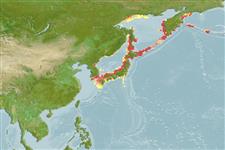Teleostei (teleosts) >
Salmoniformes (Salmons) >
Salmonidae (Salmonids) > Salmoninae
Etymology: Salvelinus: Old name for char; it is the same root of german "saibling" = little salmon (Ref. 45335).
More on author: Pallas.
Environment: milieu / climate zone / depth range / distribution range
Ecology
Marine; freshwater; brackish; benthopelagic; anadromous (Ref. 51243); depth range 0 - 50 m (Ref. 50550). Temperate; 60°N - 30°N, 127°E - 175°E
Northwest Pacific: Japan and northeastern Korean Peninsula through Sakhalin, the Kuril Islands to Kamchatka.
Size / Weight / Age
Maturity: Lm ? range ? - ? cm
Max length : 120 cm TL male/unsexed; (Ref. 56527); max. published weight: 15.0 kg (Ref. 56527); max. reported age: 9 years (Ref. 56527)
The land-locked form prefers low temperature streams, below 15°C. Young of the sea-run form enter the sea at 2 years of age and return to the rivers for spawning when they are 4 years or older. Found in summertime water temperature of 13-15° C (Ref. 12218). Carnivore, feeding on insects and plankton (Ref. 12218). Utilized fresh, smoked and frozen; can be broiled, microwaved and baked (Ref. 9988). Two forms: the land-locked form which reaches 35 cm, and the ocean form of 70 cm (Ref. 9137).
Distinct pairing (Ref. 205).
Masuda, H., K. Amaoka, C. Araga, T. Uyeno and T. Yoshino, 1984. The fishes of the Japanese Archipelago. Vol. 1. Tokai University Press, Tokyo, Japan. 437 p. (text). (Ref. 559)
IUCN Red List Status (Ref. 130435)
Threat to humans
Harmless
Human uses
Fisheries: commercial; aquaculture: experimental; gamefish: yes
Tools
Special reports
Download XML
Internet sources
Estimates based on models
Preferred temperature (Ref.
123201): 1.4 - 19.2, mean 5.1 °C (based on 106 cells).
Phylogenetic diversity index (Ref.
82804): PD
50 = 0.5000 [Uniqueness, from 0.5 = low to 2.0 = high].
Bayesian length-weight: a=0.00457 (0.00181 - 0.01153), b=3.10 (2.88 - 3.32), in cm total length, based on LWR estimates for this (Sub)family-body shape (Ref.
93245).
Trophic level (Ref.
69278): 4.4 ±0.7 se; based on diet studies.
Resilience (Ref.
120179): Medium, minimum population doubling time 1.4 - 4.4 years (tmax=5; k >0.30).
Fishing Vulnerability (Ref.
59153): High to very high vulnerability (72 of 100).
